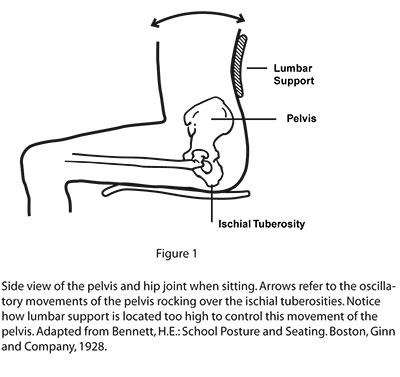Driving with Sacral Support: The Key to Preventing a Herniated Lumbar Disc
For decades, epidemiological studies have found driving a motor vehicle to be a major risk factor in developing a herniated lumbar disc.1, 2 The greater the number of hours spent driving a motor vehicle, the greater the risk for developing a herniated lumbar disc.3 In addition, the risk for developing a herniated lumbar disc is approximately twice as great for sitting while driving, compared to prolonged sitting in a chair.4
The concept of pelvic instability when sitting offers the best insight for understanding this relationship between driving and a herniated lumbar disc. According to Branton's theory of postural instability, the freedom of the pelvis to move, which is present in all sitting postures when the upper sacrum is not supported by a backrest, results in relatively fast oscillatory movements of the pelvis rocking over the ischial tuberosities (sitting bones).5, 6
Compared to sitting in an office chair without sacral support, driving without sacral support will greatly intensify this rocking of the pelvis over the ischial tuberosities. This is due to the vibration and road shock from the interaction of the moving vehicle with the road surface.
The rocking motion of the pelvis over the ischial tuberosities results in the greatest bending motion occurring at the level of the lowest lumbar vertebrae: L5 and L4.7 This correlates with the most frequent level of disc herniation being at L5-S1, the second most frequent at L4-L5.
The addition of a firm sacral support when driving will prevent the rocking of the pelvis, thereby greatly reducing the bending motion and stress on the lower two lumbar discs. Compared to sacral support, the commonly used lumbar support is positioned too high to control the rocking of the pelvis and resulting stress on the lower two lumbar discs (see Figures 1 and 2).


References
- Kelsey, J.L.: An epidemiological study of acute herniated lumbar intervertebral discs. Rheumatology and Rehabilitation, 14: 144-159, 1975.
- Kelsey, J.L.: An epidemiological study of the relationship between occupations and acute herniated lumbar intervertebral discs. International Journal of Epidemiology, 4: 197-205, 1975.
- Kelsey, J.L. et al.: Acute prolapsed lumbar intervertebral disc. Spine, 9: 608-613, 1984.
- Kelsey, J.L., and Hardy, R.J.: Driving of motor vehicles as a risk factor for acute herniated lumbar intervertebral disc. American Journal of Epidemiology, 102: 63-73, 1975.
- Branton, P.: The Comfort of Easy Chairs. Stevenage, Hertfordshire, England, The Furniture Industry Research Association, 1966.
- Branton, P.: Behaviour, body mechanics and discomfort. In Grandjean, E. (Ed.): Proceedings of the Symposium on Sitting Posture. London, Taylor and Francis, 1969, pp. 202-213.
- Sandover, J., and Dupuis, H.: A reanalysis of spinal motion during vibration. Ergonomics, 30: 975-985, 1987.